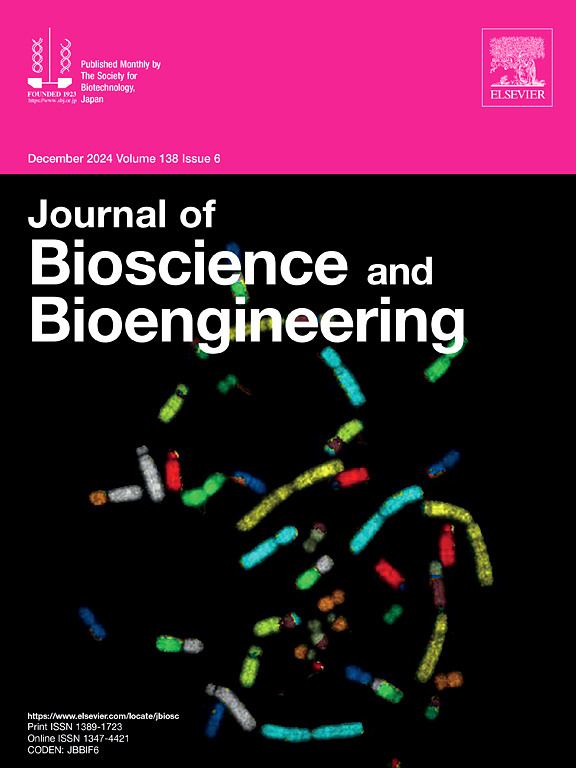Formation of epithelial polarity on the fluorinated-oil microdroplet surface by regulating cell adhesion
IF 2.9
4区 生物学
Q3 BIOTECHNOLOGY & APPLIED MICROBIOLOGY
引用次数: 0
Abstract
Polarized epithelial cells are compartmentalized into apical and basement membranes with asymmetrically distributed proteins. This study aimed to establish a method for culturing epithelial cells at the fluorinated oil (Novec-7500) microdroplet surface for the formation of epithelial polarity, which is desirable for regenerative medicine and drug discovery research. Microdroplet surfaces treated with fibronectin, which regulates a variety of cell behaviors through direct interactions with cell surface integrin receptors, were prepared for culturing epithelial cells. The cells adhered rapidly to the fibronectin-coated fluorinated oil–medium interface and reached confluence. However, as the culture time progressed, the cells began to detach from the microdroplet surface. To promote adhesion to the microdroplet interface, the cells were exposed to the Rho-associated protein kinase inhibitor Y27632, which increased the frequency of microdroplets with cells adhering to the liquid–liquid interface by 1.63-fold. However, continuous exposure to Y27632 caused the cells to detach from the microdroplet surface. When the drug was switched from Y27632 to forskolin, which enhances cell–cell and cell–substrate adhesion, the cells remained as a monolayer on the microdroplet interface. Na+/K+-ATPase and zonula occludens-2 were localized to the apical and lateral membranes of the cells, respectively, while paxillin co-localized with fibronectin at the microdroplet interface. This suggests that the cells exhibited epithelial polarity. These findings indicate that the regulation of cell–cell and cell–substrate adhesion is crucial for establishing epithelial polarity in cells cultured on the microdroplet interface.
通过调节细胞粘附力,在氟化油微滴表面形成上皮极性。
极化的上皮细胞被区隔为具有不对称分布的蛋白质的顶膜和基底膜。本研究旨在建立一种在氟化油(Novec-7500)微滴表面培养上皮细胞以形成上皮极性的方法,为再生医学和药物发现研究提供参考。制备了经纤维连接蛋白处理的微滴表面,该微滴表面通过与细胞表面整合素受体的直接相互作用调节多种细胞行为,用于培养上皮细胞。细胞迅速粘附在纤维连接蛋白包被的氟化油-介质界面上并汇合。然而,随着培养时间的延长,细胞开始脱离微滴表面。为了促进微滴界面的粘附,将细胞暴露于rho相关蛋白激酶抑制剂Y27632中,使细胞粘附在液-液界面的微滴频率增加了1.63倍。然而,持续暴露于Y27632会导致细胞从微滴表面分离。当药物从Y27632切换到增强细胞-细胞和细胞-底物粘附的forskolin时,细胞在微滴界面上保持单层。Na+/K+-ATPase和zonula occlenen -2分别定位于细胞的顶端和外侧膜,而paxillin与纤维连接蛋白在微滴界面共定位。这表明细胞表现出上皮极性。这些发现表明,在微滴界面上培养的细胞中,细胞-细胞和细胞-底物粘附的调节对于上皮极性的建立至关重要。
本文章由计算机程序翻译,如有差异,请以英文原文为准。
求助全文
约1分钟内获得全文
求助全文
来源期刊

Journal of bioscience and bioengineering
生物-生物工程与应用微生物
CiteScore
5.90
自引率
3.60%
发文量
144
审稿时长
51 days
期刊介绍:
The Journal of Bioscience and Bioengineering is a research journal publishing original full-length research papers, reviews, and Letters to the Editor. The Journal is devoted to the advancement and dissemination of knowledge concerning fermentation technology, biochemical engineering, food technology and microbiology.
 求助内容:
求助内容: 应助结果提醒方式:
应助结果提醒方式:


